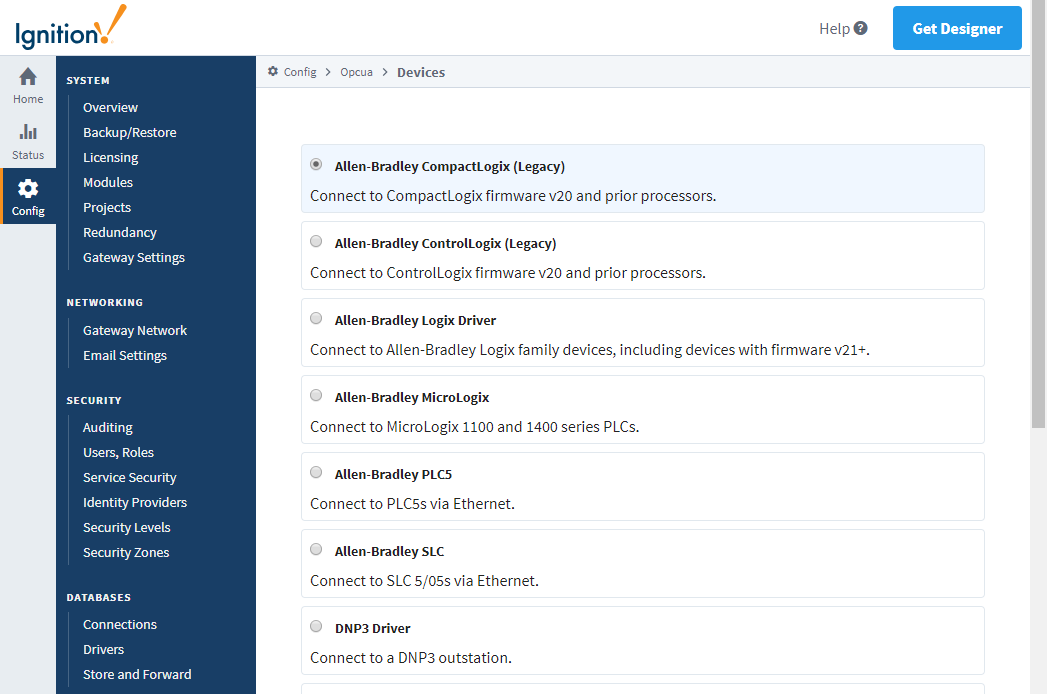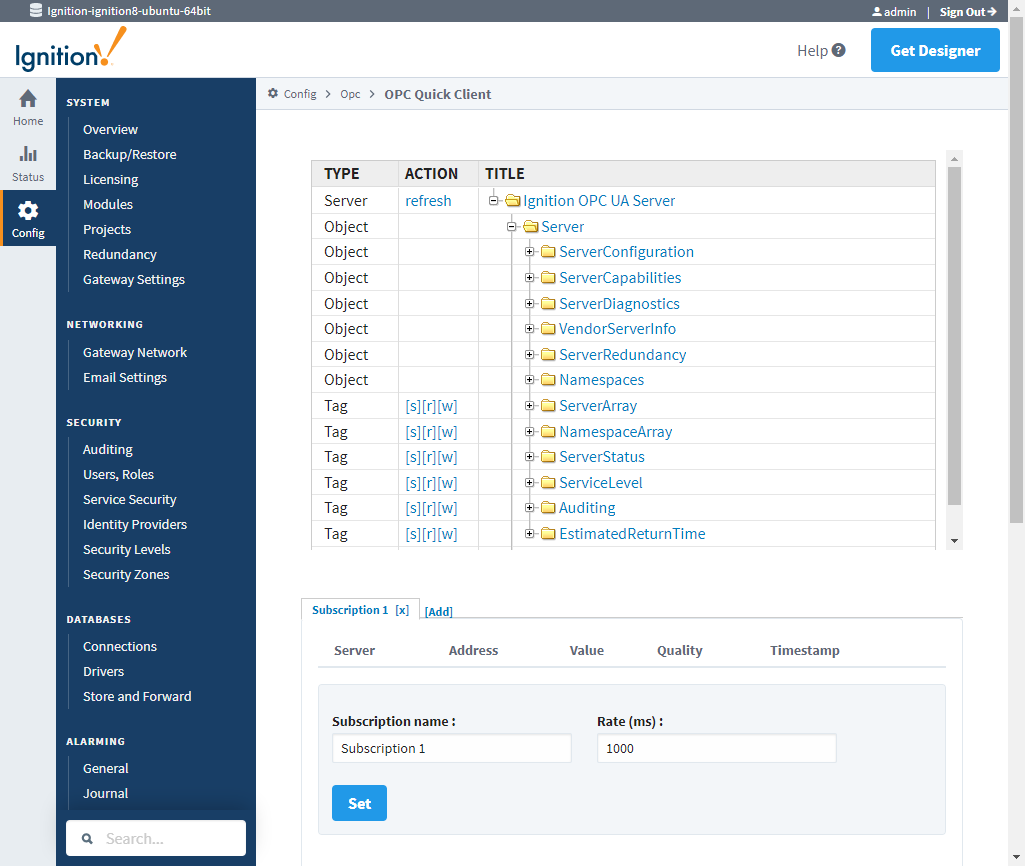OPC UA
OPC Specification
Open Process Connectivity (OPC) is a technology standard used to exchange information between hardware and software through specialized drivers. Information is exchanged between items such as programmable logic controllers (PLCs), gauges, and databases. OPC is published and maintained by the OPC Foundation, an organization comprised of hundreds of member companies that strives to ensure interoperability on the plant floor and beyond.
The original OPC specifications used Microsoft Distributed Component Object Model (DCOM) technology to provide a uniform way for industrial applications to share data. There were several separate specifications that provided functions such as Data Access (OPC-DA), Alarms and Events (A&E), and Historical data (HDA).
DCOM always proved difficult to work with, and by 2004 it was clear that a more modern solution was needed. Therefore, a new specification was developed that used common networking principles (like TCP/IP) instead of DCOM, was platform independent, and combined the various separate specifications into one: Open Process Connectivity Unified Architecture (OPC UA).
OPC UA
OPC UA is the leading industrial standard for platform and vendor-neutral data access. Connecting any PLC device to Ignition is easy with OPC UA. Device connections are done over the Ethernet for those devices that have an Ignition device driver. The OPC UA Module makes Ignition act as an OPC UA server, serving data collected by its built in drivers to other Ignition modules, as well as to third-party OPC UA clients.
OPC UA is the latest revision of the OPC specification, which offers platform and vendor neutral transfer and use of industrial data. The specification plays a crucial role in Ignition, and is the primary data access specification used in the Gateway. Ignition supports connections to any number of OPC UA servers created by any manufacturer, provided that they are compliant to the specification. The data is then used to drive all aspects of the system. Creating connections to OPC UA servers is described below in Connecting with OPC UA.
Distributed Systems with OPC UA
OPC UA breaks down boundaries and enables free data flow. Using standard TCP/IP instead of legacy DCOM, OPC UA makes it easy to securely transfer data between networks and though firewalls. All OPC UA connections are based on the same OPC, which means that a connection to your local machine is not entirely different than a connection to a machine that's far away. This enables the creation of a highly distributed system, and in combination with other features of Ignition can lead to more connected enterprises.
For example, imagine a corporate network with an office in the center, and remote processes connected through a VPN, which would pass through a variety of connections. Each remote site could have an Ignition installation running only an OPC UA module that would report data back to a central facility and record it in a database. The overall system cost would be very low. The data could be managed centrally in a single location, and then made available to all interested parties through the Vision module or any application that could access the database.
Servers and Clients
When discussing OPC (as the specifications are often called collectively), it is common to hear about OPC servers and OPC clients. An OPC server is a piece of software that implements the OPC interface and provides data. An OPC client is an application which connects to an OPC server and uses the specification to retrieve and work with data.
The Ignition platform inherently offers OPC UA client functionality. Even with no modules installed, the Gateway can connect to any compliant OPC UA server and work with data. With the addition of the OPC UA module, Ignition becomes an OPC server as well, hosting device drivers that read and publish data.
The OPC COM module is available to provide client access to older, DCOM based, OPC-DA servers.
Technology
The OPC UA specification offers a wide range of flexibility in choosing technologies, from the transport mechanism, to the way data is encoded, to the encryption used to secure the data. Ignition supports the UA/TCP transport with the UA/Binary encoding scheme for maximum performance.
Additionally, Ignition supports all of the common encryption schemes. This means that Ignition connects to OPC UA servers (and allows connections from clients) over TCP/IP using encryption, and sends data by first encoding it into an efficient format defined by the OPC UA specification. This is in contrast to other schemes outlined in the specification, which can use web services and XML encoding that are not as efficient.
Connecting with OPC UA
Connecting to a Device
With the Ignition OPC UA module and and device drivers installed, connecting to a device is simple. To quickly get connected to one of your devices, go to the Config tab of the Ignition Gateway and scroll down to OPC UA > Device Connections. The Device page will appear showing all of your installed devices.
To add a new device, click on Create New Device.... Ignition has several device drivers available, and the Device Type list is populated based on what Driver modules you have installed. Select the type of device connection you want and fill in the details for you device connection. See the device types below for more information on connecting to your specific device type:
- Allen-Bradley Ethernet
- Modbus
- Siemens
- UDP and TCP Driver
- DNP3
- Omron NJ Driver
- Omron FINS Driver
- Programmable Device Simulator
- BACnet
- IEC 61850 Driver
- Mitsubishi TCP Driver

Connecting to a Server
If you don't see the type of device you want, then you can always connect with another OPC UA or OPC DA server.
OPC Quick Client
After you connect to a device, you can access the OPC Quick Client page on the Gateway by following Config > OPC Client > OPC Quick Client. It allows for quick, simple testing of any devices connected to the server. You can browse the OPC UA Server by expanding the tree nodes, and read from or write to OPC tags by clicking on the [r] and [w] links next to the tags.
Clicking on the [s] link will create a subscription and show live value changes in the Subscriptions area at the bottom of the screen. Use the Set button to confirm any changes made in the Subscription name and Rate (ms) fields.

How Do I Get Data from My PLC?
Getting data from your PLC into Ignition is a two step process:
- Add a device, see Connecting to a Device.
- Add some tags, see Creating Tags.
It requires you to touch both the Ignition Gateway and the Ignition Designer. There are also some limitations as to what kind of devices you can connect to Ignition and these are explained throughout the user manual, however, included below is an overview of what you can expect when it comes to compatibility.
Brief Summary of Device Connection in Ignition
- Ignition can only connect directly to devices over Ethernet.
- Ignition can only connect directly to devices for which there is an Ignition device driver. Visit the OPC UA Drivers page for an overview of supported devices and drivers.
- Ignition can connect to third party OPC servers via OPC UA or OPC-DA (using the OPC-COM module) for devices that do not have a supported driver.
Adding a Device to Ignition
Ignition Supported OPC UA Device
Most commonly you will be adding a device that is supported by one of the built-in device drivers. The first step is connecting your device to Ignition. This is done through the Ignition Gateway Config tab under the OPC UA > Device Connections page.
- Click Create new Device....
- Select the driver for the device you wish to add. Click Next.
- When adding a device you will notice that there are some common settings that are shared by all devices. You can find an explanation of these settings on the individual page for each OPC UA Driver.
- Specify any of the required device specific settings for the device (for example, hostname, etc.)
- Check the status of your device to see if it is connected.
As long as all the device information you entered was correct you should see your device in a connected state. The only exception to this is if you chose to add a Siemens or Modbus device. Since these devices don't support the browsing of Tags, you will have to create and address some Tags in the Ignition Designer before the device will stop cycling from a connected to disconnected state.
If you need to address your Tags for your Siemens or Modbus device, you'll want to read about adding Tags in the Ignition Designer as well as how addressing works for the different protocols. You will have to first add a Tag in the Ignition Designer and then edit the OPC Item Path of the Tag using the appropriate addressing scheme.
Adding Connection to Third Party OPC Server Via OPC UA
If your device does not have an Ignition driver, you can use a third party OPC server to connect to your device and then have Ignition connect to the server as a client. If the OPC server offers support for OPC UA, you can add a new OPC UA server connection in the Ignition Gateway. For more information, see the OPC UA Client Connection Settings page. Additionally, the Connecting to Kepware OPC UA is useful when connecting to Kepserver.
Adding Connection to Third Party OPC Server Via OPC COM
When attempting to connect Ignition to an OPC COM server, the OPC COM module must be installed. More information about configuring OPC COM connections can be found on the OPC COM page.